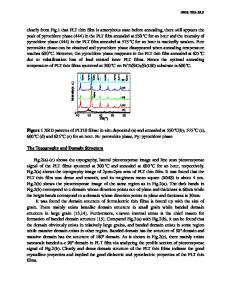Structural Properties of Thin Films Obtained by Magnetron Sputtering of Polydiacetylene
- PDF / 886,193 Bytes
- 7 Pages / 612 x 792 pts (letter) Page_size
- 96 Downloads / 321 Views
ACE PHYSICS AND THIN FILMS
Structural Properties of Thin Films Obtained by Magnetron Sputtering of Polydiacetylene O. A. Streletskiia, I. A. Zavidovskiia,*, O. Yu. Nishchaka, A. N. Shchegolikhinb, and N. F. Savchenkoa a Moscow
b
State University, Moscow, Russia Emanuel Institute of Biochemical Physics of Russian Academy of Sciences, Moscow, Russia * E-mail: [email protected] Received May 21, 2020; revised June 12, 2020; accepted June 14, 2020
Abstract—Films obtained by radio-frequency sputtering of monocrystalline polydiacetylene (PDA) are under study. The structure is studied by Raman spectroscopy, transmission electron microscopy, and X-ray photoelectron spectroscopy. It is shown that the obtained films have a heterogeneous structure containing agglomerates of nanosized inclusions of the initial PDA and irregular sp/sp2 hybridized carbon chain fragments. Keywords: polydiacetylene, magnetron sputtering, transmission electron microscopy, Raman spectroscopy, X-ray photoelectron spectroscopy DOI: 10.1134/S1063783420110360
1. INTRODUCTION Nanostructured materials prepared by embedding nanosized particles into a matrix of a thin film are currently a research subject of many scientific groups [1–5]. The inclusion of nanoparticles in the material makes it possible to significantly modify the properties of the structure. Such materials can demonstrate such effects as confinement, quantum-dimensional Stark effect, surface-enhanced Raman scattering, etc. [6– 8]. Materials with embedded nanoclusters can be used as functional coatings, nanoelectronic elements, biosensors, active optical media, etc. [9–11]. The study of thin-film structures with polymer inclusions is of particular interest. However, the existing methods for the synthesis of such films can be rather complicated [12–14]. Therefore, the prospects for their application are associated with the study of the possibility of creating materials containing polymer nanoclusters using widespread and universal technologies for obtaining thin-film coatings, one of which is magnetron sputtering. The investigations of films prepared using magnetron sputtering of polymer targets were carried out in [15–17]. The choice of polymers was determined by the prospect of creating the coatings with specified properties. Thus, the transfer of polytetrafluoroethylene (teflon) [15, 16] made it possible to synthesize the hydrophobic coatings, and the films obtained by sputtering of polyimide showed good tribological and strength characteristics [17, 18].
In the present work, the monocrystalline polydiacetylene (PDA) served as a sputtered polymer. The type of PDA used for sputtering is known in the literature under the abbreviation PTS [19]. Monocrystals of this material are built of identically oriented polymer chains having a quasi-one-dimensional carbon skeleton consisting of π-conjugated alternating C≡C, C=C, and C–C bonds. Polydiacetylenes obtained as a result of solid-phase topochemical polymerization (STP) show a number of unique properties, such as thermochromism, pie
Data Loading...










